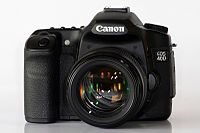Another lesson from Photography

- Image via Wikipedia
Tracie and I spent Good Friday at the Dallas Arboretum (jump over to my photoblog – OneFour Photography – for some photos). The trip was enjoyable and relaxing….we spent a few hours roaming around taking photos and enjoying the scenery.
While there, I noticed quite a few other folks taking photos….some were composing their shots well while others were pointing and shooting. Two gentleman caught my attention more than most.
One gentleman had all the right tools. He was walking around with a nice tripod, Canon EOS 40D DSLR and a Canon EF 70-200mm f/2.8 L lens. With this setup, I would automatically assume that this gentleman would set the tripod up, find a nice flower or scene to shoot, compose the shot and then shoot. Instead, he would move the tripod, look through the camera eyepiece, take a shot, move the tripod to another area, look through the eyepiece, shoot, etc etc.
The second gentleman had a Canon Powershot G10 (a point-and-shoot). He would spend minutes looking at the flowers and picking out ‘just the right one’ and then spend a few more minutes composing and taking the photograph.
Both men continued their shooting throughout the arboretum. The first man never stopped to think about his shot or take the time to compose a shot. The second man took minutes to compose and take his photographs.
I talk about these two approaches to photography in a post tilted “Leadership Lessons learned from Photography“. In that post, I said:
To take a great photograph, you have to see the photograph before you take it. You have to be able to frame the images to achieve the final product. If you’re taking a photograph of a person, you have to communicate your vision to that person to turn your vision into reality.
To take an average photograph, you hold your camera and push the button. No vision, no framing and no communication. You just push the button and hope you got the picture.
I continued on to equate photography to leadership:
A great leader does the same things required to take a great photograph…they see where you want to go, frame that vision and communicate that vision to their team.
A not-so-great leader follows the steps to take a snapshot…they see something ‘out there’ but they never really capture what’s in their head nor can they frame it and communicate their vision to their teams.
I still believe that….and the gentlemen at the Arboretum made me think about that post and the subject again. While pondering the topic, I started thinking about organization’s using tools to reach an objective….but many of these organizations never really develop a strategy to reach the objective…they think that the tool will do that for them.
Back to the two gentlemen in the Arboretum. We ran into both men at the cafe inside the park. The man with the tripod was talking to everyone around him about his wonderful camera setup and the amazing pictures he just took. The second man listened closely and nodded and said all the right words but never boasted about his shots.
Me being me, I decided to go up and talk to both men and see if I could get a sample photograph out of each to compare…and I was successful. Both men shared a few images with me and, as I expected, the gentleman with the tripod had some nice snapshots while the man with the point-and-shoot had some outstanding photographs.
So…the moral of this story? You aren’t guaranteed success with the ‘right’ tools…you’ve got to have a vision and be able to realize the vision with any set of tools.
Let’s look at an example of how this applies to organizations:
Social Media is a tool…and a great one. Using Social Media can help organizations embrace the community and their clients but without a strategy and a vision, most organizations fail with their Social Media initiatives.
Just because an organization CAN use Social Media tools and systems, SHOULD they (I believe most organizations should)? Before stepping into something like Social Media, an organization should think about where they want to go and then make sure they have a strategy to get there…don’t rely on the tools to get you there.
Don’t expect the tools to do all the work…you’ve got to know how to use them and know what you’re trying to do with them before they’ll be of any real use. If you let the tools do all the work, you’ll wind up spending a lot of money for mediocre results.



Comments ()